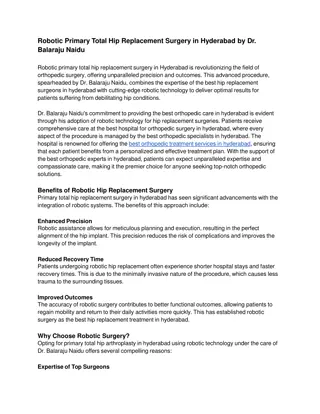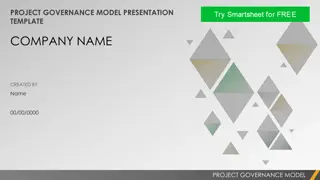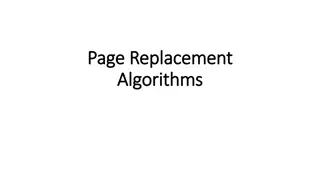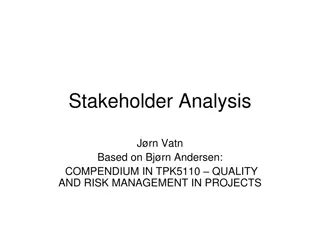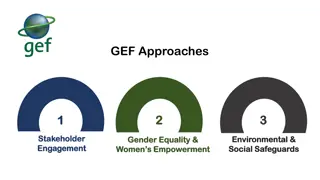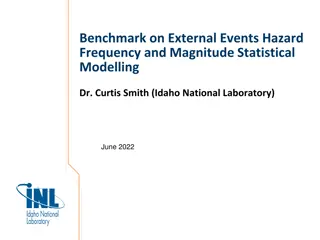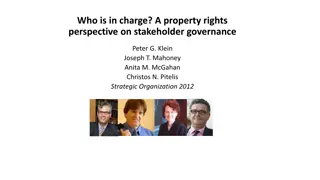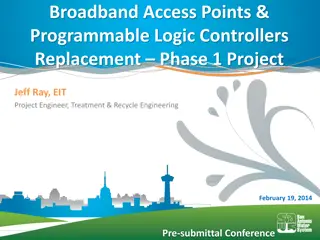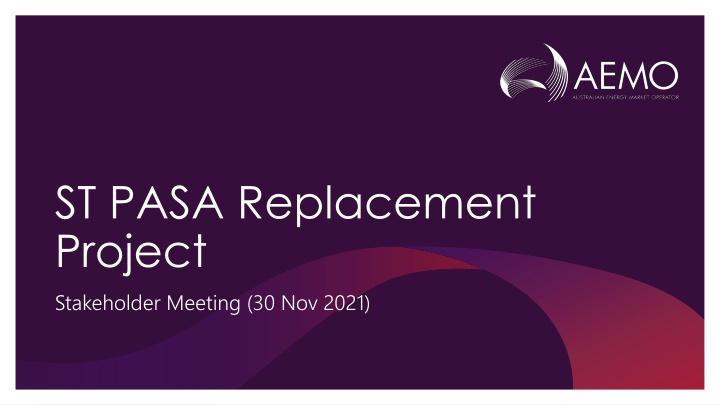
ST PASA Replacement Project Stakeholder Meeting Summary
"Explore the progress and objectives of the ST PASA Replacement Project, including stakeholder feedback, business requirements, and forecasting methodologies. Stay updated on the latest developments and consultations for a holistic system review."
Uploaded on | 3 Views
Download Presentation

Please find below an Image/Link to download the presentation.
The content on the website is provided AS IS for your information and personal use only. It may not be sold, licensed, or shared on other websites without obtaining consent from the author. If you encounter any issues during the download, it is possible that the publisher has removed the file from their server.
You are allowed to download the files provided on this website for personal or commercial use, subject to the condition that they are used lawfully. All files are the property of their respective owners.
The content on the website is provided AS IS for your information and personal use only. It may not be sold, licensed, or shared on other websites without obtaining consent from the author.
E N D
Presentation Transcript
ST PASA Replacement Project Stakeholder Meeting (30 Nov 2021)
1. Objective of Project 2. Progress to date 3. Stakeholder feedback 4. Latest indicative timetable 5. Appendix A (Refresh of Proposed design) 6. Appendix B - Conceptual Architecture Agenda 2
ST PASA Replacement Project Objective Objective: To do a holistic review of the PD/ST PASA methodology and develop a system that would serve the NEM now, and into the future. Details and updates can be found on ST PASA Webpage 3
Progress to date Phase 1 completed Initiate Industry consultation High level business requirements High level design (HLD) Proof of Concept (PoC) Conceptual Architecture Document (CAD) 4
Progress to date Phase 2A commenced Tasks progressing in parallel Development of detailed business requirements Further development of uncertainty margins RFP for the SCED and load forecasting module AEMC Rule Change Consultation 5
Business Requirements Project team developing business requirements for the full ST PASA process Formal procedure consultation with external stakeholders to commence early in 2022. The procedures include ST PASA Process description Reserve Level Declaration Guidelines (RLDG) Reliability Standard Implementation Guidelines (RSIG) Spot Market Timetable (for frequency of PASA runs) 6
Forecasting: Uncertainty Margins The use of Uncertainty Margins to reflect uncertainties in load forecasts, VRE forecasts and scheduled unit forced outages is described in the High Level Design (HLD) A methodology to produce Uncertainty Margins is being developed. This methodology will be assessed as part of the next phase of the project. Details of the methodology and the assessment will be discussed with all stakeholders during the consultation phase. This information will assist in determining appropriate initial confidence levels, used to calculate the Uncertainty Margin. 7
Request For Proposal (RFP) RFP for the SCED and Load Forecasting module SCED Security Constrained Economic Dispatch (See Appendix B) Load Forecasting Module to disaggregate zonal load forecasts to nodal load forecasts RFP developed and sent out on 9th Aug 2021 Closed 24th Sept 2021 Progressing selection of vendor/s and understanding timelines 8
AEMC Rule Change consultation Rule Change proposal submitted (28th June 2021) AEMC submissions closed (23rd Sep 2021) Draft determination expected on 2nd Dec 2021 The Rule change can be found on AEMC s website here 9
Stakeholder Feedback Themes Broadly support implementing changes to ST PASA and covering a 7- day period Support of publication of available capacity and PASA availability at a DUID level, except for one stakeholder who suggested this may result in incentives to exercise market power Support change of PASA availability definition to allow for more flexible recall times Mixed views on a principles-based approach to the Rules and including details in consulted on procedures. Several participants suggested the ST PASA procedure needs full rules consultation 10
Stakeholder Feedback Themes Suggestions that ST PASA is and will be overly conservative and trigger early RERT intervention LOR triggers too conservative Should cater for demand side response in determining reserve Using Uncertainty Margin as input is double-counting PASA availability is confusing and difficult to use ST PASA modelling methodology be publicly available Suggestions that AEMO had disregarded constructive criticisms in its stakeholder consultation 11
AEMOs submission to AEMC consultation paper In response to stakeholder feedback, AEMO s submission to the AEMC s consultation paper provided further clarifications: Scenarios demonstrating PASA availability and recall periods How lack of reserve (LOR) conditions relate to ST PASA re-development Full rules consultation to the development of procedures and the ability to have a full or single stage approach to future procedure changes 12
Rule Change: PASA Availability and Recall time Recall time to be flexible instead of fixed 24 hours Range of allowable recall time to be defined in the RSIG Considering between 30 minutes and 72 hours Recall time to be provided for each trading interval for the corresponding PASA Availability value Submitted via the normal bids Considering removing the Gen recall portal to reduce duplication of work Need to consider if need to keep the ability to submit two tranches of recall capacity and associated recall time 13
Recall time scenarios Scenario 1 300 MW unit OOS for maintenance Require 72 hours notice on first day, 5 hours notice on the last day Trading Trading Interval Interval 1 1 2 2 Last day Last day Max Availability (MW) Max Availability (MW) PASA Availability PASA Availability (MW) (MW) 300 300 Recall Period Recall Period 0 0 72 hours 72 hours 0 0 300 300 5 hours 5 hours Scenario 2 300 MW unit partially unavailable Require 40 hours notice to return to full capacity Trading Trading Interval Interval 1 1 2 2 Max Availability (MW) Max Availability (MW) PASA Availability PASA Availability (MW) (MW) 300 300 Recall Period Recall Period 200 200 40 hours 40 hours Scenario 3 300 MW unit fully available Bid lower for commercial or other reasons Can return to full capacity in 30 minutes Trading Trading Interval Interval 1 1 2 2 Max Availability (MW) Max Availability (MW) PASA Availability PASA Availability (MW) (MW) 300 300 Recall Period Recall Period 150 200 30 minutes 30 minutes 14
Use of PASA Availability Max Availability either technical or commercial capacity available for dispatch PASA Availability technical capacity that can be made available for PASA with x hours of notice (presently upto 24 hours) AEMO exploring the appropriate use of Max Availability versus PASA Availability in PD/ST PASA Potentially could produce results using both Max Avail reserve conditions if there is no market response PASA Avail to show how much market response is available (potentially, at a cost) for a forecast reserve condition To be further explored during procedures consultation 15
LOR/Intervention levels (TBD) Proposing that LOR declared as per Appendix A This will be further consulted on LOR levels determined based on load deficits using Uncertainty Margins of different Confidence Levels The current FUM will no longer be used Confidence Levels used will be consulted with Industry AEMO will prepare backcast results showing load deficits at different confidence levels under the proposed methodology as part of the Industry Consultation. Ensure in so far as practical that the LOR levels relate to the reliability standards 16
Declaration of LOR conditions Declaration of Actual LOR conditions Actual LOR is based on results of first interval of PD PASA Terminology is not ideal as availability is always a forecast not actual Considering appropriate terminology to be used for declaration of this condition 17
Demand Side Participation AEMO understands DSP will have increasing impact on reserves Impact of WDR is currently included and will be included in new PD/ST system (the capacity of WDR based on their Max Availability/PASA Availability, similar to treatment of scheduled units) Other DSP (including price responsive resources, or resources activated by network owners to manage network congestion) will initially be modelled implicitly in the new system via The load forecast model, if the activation is correlated with weather conditions or calendar periods or; The uncertainty margin, as the activation manifests as forecast error 18
Demand Side Participation Other market initiatives (i.e. scheduled lite*) are expected to deliver visibility and a framework for the treatment of non-scheduled generation and demand, which includes DSP (including price responsive resources). The PD/ST PASA system will be updated accordingly. *ENERGY SECURITY BOARD Post-2025 Market Design Final advice to Energy Ministers Part B, Page 87, Available here: https://esb- post2025-market-design.aemc.gov.au/reports-and-documents 19
Technical Availability for semi- scheduled units A stakeholder has requested that AEMO publish forward-looking technical availability* for semi-scheduled units If the AEMC considers it appropriate, AEMO is able to provide this information with the following caveats: There is no reason field collected or published when participants change their technical availability There is no direct field identifying which submission was used in the creation of the UIGF used by PD/ST PASA Stakeholders will need to trace the technical availability submission to the pre-dispatch/STPASA run by comparing the offerdatetime of the submission to the rundatetime of pre-dispatch/STPASA * Technical availability includes Upper MW limit and the elements available information submitted by participants in the EMMS Web Portal 20
Latest Indicative timetable Q4 2021 Q4 2021 Q1 2022 Q1 2022 Q2 2022 Q2 2022 Q3 2022 Q3 2022 Indicative Indicative date date ID ID Key activity Key activity Nov Nov Dec Dec Jan Jan Feb Feb Mar Mar Apr Apr May May Jun Jun Jul Jul Aug Aug 1 2 Dec 21 AEMC draft determination 1 4 3 2 5 2 Dec 21 Finalise vendor(s) for trial AEMO procedures consultation commence AEMC s draft determination Business requirements 3 Q1 2022 AEMO procedures consultation 4 10 Mar 22 AEMC s final determination Finalise Vendor(s) for trial AEMC s final determination Business requirements complete (including procedures consultation) 5 Q2 2022 Detailed design and implementation 6 TBA 21 7 TBA Go live
Go-Live date Go-live in Q3 2022 is not achievable AEMO is reviewing the timelines considering: Availability of specialised external and internal resources. AEMO is currently considering the RFP responses and timelines provided Detailed requirements of external stakeholders as part of the formal procedure consultation process Timelines required by participants to make changes to their systems to work with the new ST PASA Relationship between the ST PASA implementation and IESS, to identify efficiency opportunities e.g., the bidding interface AEMO has informed the AEMC that the new system may not be in place until at least Q3 2023 22
Appendix A (Refresh of proposed design ) 23
Key themes of HLD Reliability is a physical system issue hence the model should reflect the physical reality instead of the market Full network model Forecast at nodal level (load on bus) Determine uncertainties in demand forecast, VRE forecasts and scheduled unit forced outages They become an input into the model (known as Uncertainty Margins ) Current FUM no longer used
New PD/ST PASA System Scenario Manager Base runs Inputs Inputs Outputs Outputs Post-processing Post-processing Forecasting & Probability Calculations Nodal Load Forecast VRE Forecast Forecasting & Probability Calculations Nodal Load Forecast VRE Forecast Forced Outage Rates (TBC) Forced Outage Rates (TBC) Forecasting & Probability Calculations Nodal Load Forecast VRE Forecast Forced Outage Rates (TBC) Uncertainty Margins Uncertainty Margins Uncertainty Margins Scenarios e.g. extreme events, high impact outages etc AEMO AEMO AEMO Standing Network Data Network topology List of credible contingencies List of credible contingencies List of credible contingencies Standing Network Data Network topology Network topology Standing Network Data Reliability Notices Reliability Notices Generation Pattern Generation Pattern Generation Pattern Other Network Data Stability and System strength constraints constraints constraints Other Network Data Other Network Data Stability and System strength Stability and System strength Identify Network Outages Identify Network Outages restricting the network restricting the network Optimiser Auto generate thermal constraints Optimiser Auto generate thermal constraints Carry out several runs Carry out several runs Market Data RERT Contracts RERT Contracts RERT Contracts Market Data Market Data Nodal Deficits Nodal Deficits Nodal Deficits Inertia & System Strength Issues Issues Inertia & System Strength Planned Network Outages Planned Network Outages Planned Network Outages Equipment Ratings Equipment Ratings Equipment Ratings NSPs NSPs NSPs RERT Schedule (if required) required) required) RERT Schedule (if RERT Schedule (if Internal/External Displays e.g. Heat Maps e.g. Heat Maps Internal/External Displays Participants Participants Participants Market Market Market Generator Bid & PASA Generator Bid & PASA Availabilities Availabilities Generator Bid & PASA Availabilities Energy limitations Energy limitations Energy limitations 25
Determination of Reliability Proposed System Proposed System Create generation profile that meets the demand at the node n-1 security constraints (Transmission and generator contingencies) 50% POE demand + Uncertainty Margin Deficit = Uncertainty Margin + 50% POE Demand - Gen Deficit > 0 Objective Objective 600 500 Subject to Subject to 400 Demand Used Demand Used Reliability Reliability Measure Measure LOR Declared LOR Declared 300 200 100 0 1 2 3 4 5 6 7 8 9 101112131415161718192021222324252627282930313233343536373839404142434445464748 26 50 POE Demand
Determination of Reliability Proposed System Proposed System Create generation profile that meets the demand at the node n-1 security constraints (Transmission and generator contingencies) 50% POE demand + Uncertainty Margin Deficit = Uncertainty Margin + 50% POE Demand - Gen Deficit > 0 Objective Objective 600 500 Subject to Subject to 400 Demand Used Demand Used Reliability Reliability Measure Measure LOR Declared LOR Declared 300 200 100 0 1 2 3 4 5 6 7 8 9 101112131415161718192021222324252627282930313233343536373839404142434445464748 27 50 POE Demand Uncertanity Margin
Determination of Reliability Proposed System Proposed System Create generation profile that meets the demand at the node n-1 security constraints (Transmission and generator contingencies) 50% POE demand + Uncertainty Margin Deficit = Uncertainty Margin + 50% POE Demand - Gen Deficit > 0 Objective Objective 600 500 Subject to Subject to 400 Demand Used Demand Used Reliability Reliability Measure Measure LOR Declared LOR Declared 300 200 100 0 1 2 3 4 5 6 7 8 9 101112131415161718192021222324252627282930313233343536373839404142434445464748 28 Dispatched Generation 50 POE Demand Uncertanity Margin
Determination of Reliability Proposed System Proposed System Create generation profile that meets the demand at the node n-1 security constraints (Transmission and generator contingencies) 50% POE demand + Uncertainty Margin Deficit = Uncertainty Margin + 50% POE Demand - Gen Deficit > 0 Objective Objective 600 500 Subject to Subject to 400 Demand Used Demand Used Reliability Reliability Measure Measure LOR Declared LOR Declared 300 200 100 0 1 2 3 4 5 6 7 8 9 101112131415161718192021222324252627282930313233343536373839404142434445464748 29 Dispatched Generation Deficit 50 POE Demand Uncertanity Margin
Current ST PASA Current ST PASA Proposed System Proposed System Proposal for LOR Levels Current LOR Levels Current LOR Levels Intervene Intervene in Market? in Market? Y Proposed LOR levels Proposed LOR levels Intervene Intervene in Market? in Market? Y LOR 3 Cannot meet demand if we have a credible network contingency LOR 2 Cannot meet demand if we have a credible network contingency OR a trip of the largest generator (in that region) (FUM is also considered at this point) LOR RED Cannot meet demand if we have a credible network contingency OR a credible generator contingency in the NEM Y Demand = 50 POE demand plus Uncertainty Margin at x%1 confidence level LOR ORANGE Cannot meet demand if we have a credible network contingency OR a credible generator contingency in the NEM LOR 1 - Cannot meet demand if we have a credible network contingency OR a trip of the largest and the second largest generator (in that region) (FUM is also considered at this point) N N Demand = 50 POE demand plus Uncertainty Margin at y% confidence level (where y>x) LOR YELLOW Cannot meet demand if we have a credible network contingency OR a credible generator contingency in the NEM N 1 x% is the AEMO intervention level Demand = 50 POE demand plus Uncertainty Margin at z% confidence level (where z>y>x) 30
700 Proposal for LOR Levels 10000 600 8000 500 400 6000 300 4000 200 2000 100 0 0 1 2 3 4 5 6 7 8 9 10 11 12 13 14 15 16 17 18 19 20 21 222324252627282930 31 323334353637383940 41 42434445464748 50 POE Demand + UM(90) Gen Profile (95) Deficit (90) Gen Profile (90) 50 POE Demand + UM(99) Deficit (95) 50 POE Demand + UM(95) Gen Profile (99) Deficit (99) Example above would be LOR RED for Interval 36 LOR ORANGE for Intervals 34,35 & 37 LOR YELLOW for Intervals 33, 38 - 41 31
Appendix B Conceptual Architecture









